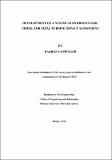| dc.contributor.advisor | Nash, Stephen | |
| dc.contributor.author | Coppinger, Darren | |
| dc.date.accessioned | 2016-05-12T14:54:37Z | |
| dc.date.issued | 2016-05-12 | |
| dc.identifier.uri | http://hdl.handle.net/10379/5778 | |
| dc.description.abstract | Tidal current energy resources have the potential to provide a sizable proportion of our future energy requirements. However, significant questions still exist on the impacts of tidal turbines on the hydrodynamic environment. This thesis is concerned with the development of a 3D nested hydrodynamic model capable of simulating energy extraction from coastal waters via tidal turbines. Of particular interest was the ability of the model to simulate the hydrodynamic impacts of tidal turbine devices and the interactions between adjacent devices in an array. Due to high computational costs, most hydrodynamic models of coastal waters are resolved at scales much larger than the typical size of tidal turbine rotor diameters. As a result, they cannot be used to accurately simulate turbine impacts and interactions. Nested models allow high resolution in an area of interest only, without the cost of high resolution across the full model domain. The 3D Nested Turbine Model (3DNTM) was developed to facilitate selective high resolution around a turbine array, at similar scales to the turbine rotor diameters, in an effort to better capture turbine interactions.
To 3DNTM was developed and validated in two stages. First, a 3D tidal turbine extraction model was developed and the model results were compared to those from a previously published one-dimensional (1D) model study. This model was also applied to the Severn Estuary to demonstrate its ability to capture the change in vertical velocity profile due to turbine rotors and support structures and to incorporate a thrust coefficient that changes in response to a turbines defined cut-in and rated speeds. Second, one-way and two-way nesting functionality was added to the model and the model results were compared to a high resolution single grid model solution to assess the model accuracy. The final 3DNTM was then used to reproduce scaled turbine experiments and the model results were compared with experimental data.
The results show that the 3DNTM is capable of simulating the interaction between individual tidal turbines in an array, and hence the hydrodynamic impacts of these turbines, at a similar accuracy to a single grid high resolution model of the same domain. The model also provides significant computational savings when compared to a single grid high resolution model of the same domain. | en_IE |
| dc.rights | Attribution-NonCommercial-NoDerivs 3.0 Ireland | |
| dc.rights.uri | https://creativecommons.org/licenses/by-nc-nd/3.0/ie/ | |
| dc.subject | Tidal turbine | en_IE |
| dc.subject | 3D | en_IE |
| dc.subject | Energy extraction | en_IE |
| dc.subject | Hydrodynamic model | en_IE |
| dc.subject | Nested | en_IE |
| dc.subject | Civil engineering | en_IE |
| dc.title | Development of a nested 3D hydrodynamic model for tidal turbine impact assessment | en_IE |
| dc.type | Thesis | en_IE |
| dc.contributor.funder | IRCSET | en_IE |
| dc.contributor.funder | SEAI | en_IE |
| dc.local.note | This thesis details the development of a 3D nested model with the capability to more accurately simulate the effects of tidal turbine on the hydrodynamic environment compared to the equivalent 2D model, particularly in the change of velocity in vertical profiles due to energy extracted by the turbine rotor and the effects of structural drag. | en_IE |
| dc.description.embargo | 2017-02-13 | |
| dc.local.final | Yes | en_IE |
| nui.item.downloads | 926 | |


